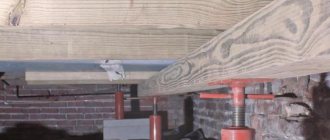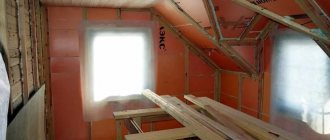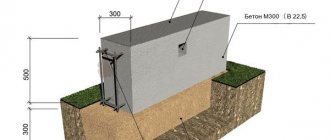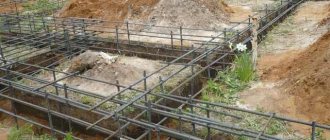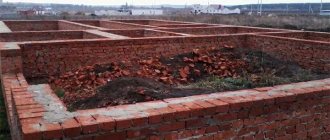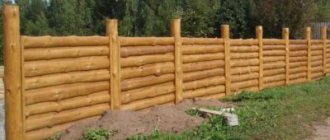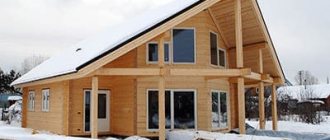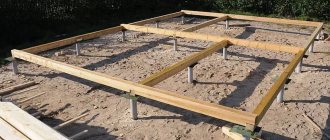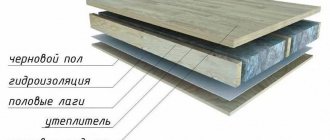Pouring the foundation is one of the first stages of building a house. Theoretically, there is nothing complicated about this - you dug a hole, filled the bottom with sand, poured concrete on top, and all you have to do is wait until the cement hardens. But in fact, only professional builders know how to properly pour the foundation for a house; There are quite a lot of nuances here - from the installation of formwork to the correct vibration of already poured concrete, not to mention the fact that this work is hard and dirty.
Pouring a strip foundation - this job definitely cannot be called clean Source beton-rbu.by
Information about the soil and nearby buildings
Starting to do something without prior preparation is simply unwise. The beginning of all beginnings in construction is the preparation of project documentation; and designing a house and foundation, in turn, can only be done based on the results of a geological examination of the site, which will reveal the individual characteristics of the soil and take into account the relief.
The lowest freezing point of the soil in winter will allow you to determine the type of foundation and its depth. It is better to entrust a detailed analysis of the soil and the choice of foundation type to qualified specialists.
Landscape design will help you choose the most convenient location of the house, auxiliary buildings, paths and gazebos. Modern technologies allow you to see your future home from all angles.
The linear dimensions of the base are only part of the foundation design Source moifundament.ru
Tape: calculation algorithm
This issue is given great importance at FORUMHOUSE.
al185MODERATOR FORUMHOUSE
I beg you not to prescribe a foundation design based on “people’s experience” and the advice of various advisors who “have always built this way.”
A member of our portal with the nickname MaximGvozdev created the LentaOnline v calculator. 1.0, which will help with the construction of this type of foundation. The tool can calculate the resistance of the foundation soil, the width and length of the designed tape, reinforcement and concrete, concrete composition, and the number of concrete batches in a concrete mixer.
For beginners, the FORUMHOUSE moderator with the nickname al185 recommends first deciding on the soil conditions (soil composition, groundwater level, topography) to design a strip foundation and resort to the following methods:
- Ideally, order a project from an adequate designer who can get good recommendations on FORUMHOUSE.
- You can borrow an already calculated analogue foundation design for similar soil conditions and a similar building.
- Master design for amateurs: an algorithm for designing a strip foundation for dummies.
Next, you need to compare the cost of the options received and choose the appropriate one.
Preparatory work
The preparatory work stage occupies an important place in the process of building a house. First of all, it is necessary to clear the area of construction debris, cut down excess trees and uproot stumps, and remove dry grass.
Preliminary zoning of the site will allow you to effectively use every corner during operation. It is best to level the surrounding area before starting construction work and laying the foundation. This will not only give the site an attractive appearance, but will greatly facilitate construction work at all stages. The terrain with large differences requires stepwise leveling of the territory.
Next, the exact location of the house is determined and the foundation is marked. To do this, pegs are installed in all corners of the future building. If the house is a standard rectangular shape, the result should be a figure with perfectly equal angles of 90°. If the angle is not maintained, it is necessary to achieve this result by moving the limit cord in one direction or another.
Along the future walls, at the same distance from each other, pegs are also installed and a rope or cord is pulled between them. The diagonals drawn between the corners of the building must be exactly equal to each other.
An example of checking angles in markings - if the diagonals are equal, then all angles are 90° Source homeframe.ru
When marking for a strip foundation, it is necessary to retreat from the walls of the house at a distance equal to the width of the foundation. Most often this figure is no more than 20 cm.
You can dig a trench either by hand or using specialized equipment. It is formed at least 20 cm below the freezing point of the ground, characteristic of the area in winter. It is necessary to dig a trench strictly following the markings and forming a flat bottom.
Preparing the work site
The area designated for the construction of the foundation must be thoroughly cleared of debris and tree roots. The top layer of soil is removed. Next, using pegs and rope, the territory is marked, indicating the lines for pouring the concrete strip.
Methods for saving a house foundation
One of the exciting questions when building a house is how to lay the foundation for a house cheaply and with high quality. There are several ways to save at least a little:
- Digging the soil and pouring the foundation for a house with a concrete mixture is the most expensive stage in the construction of a country house. Whether to do all the work yourself or entrust it to professionals - everyone decides for themselves.
- Forming a shallow foundation will save a significant amount of money. However, it is only suitable for the construction of low-rise buildings made of lightweight materials. In all other cases, a deep foundation is used, erected below the freezing point of the ground.
- The formwork is assembled from boards, which can later be used as a subfloor or for other work in which the appearance of the material will be of secondary importance.
After the concrete has hardened, the formwork boards are removed and can be reused Source sovet-nso.ru
See also: Catalog of companies that specialize in foundation repair and design.
- When pouring a slab foundation, you can save money by using a thinner base with the formation of stiffeners.
- The possibility of using fiberglass reinforcement instead of steel materials will also allow for minor savings.
Assembling the reinforcement cage
Reinforcement with steel reinforcement provides increased strength of the monolith, which can withstand soil movements and the weight of the structure. For reinforcement, steel rods with a diameter of 0.8–1.4 cm are used. The dimensions of the spatial reinforcement frame and the diameter of the rods are selected according to preliminary calculations. Assemble the reinforcement cage in the following order:
- Place steel rods with a diameter of 1 cm at the base of the pit inside the formwork.
- Install non-metallic pads under the reinforcement, ensuring a guaranteed gap to the crushed stone-sand cushion of 40–50 mm.
- Secure the lower level transverse rods with tying wire.
- Assemble and secure with tying wire the bars of the upper level of the reinforcement cage.
- Form a spatial structure by securely fixing the upper and lower tier to the vertical rods.
Use only tying wire to make reinforcement cage. The use of electric welding causes stress concentration in the welding zone of reinforcing bars and can cause structural failure.
Reinforcement of the foundation before pouring concrete mixture
Features of pouring a slab foundation
Slab foundations are most often used in the construction of brick, frame and stone country houses. In this case, the slab is located not only under the load-bearing walls of the house, but also under the entire structure and requires the formation of a perfectly flat surface.
To fill a slab foundation, a sand cushion up to 30 cm high is poured, reinforced concrete slabs are laid, a reinforcing frame is formed and a concrete screed is made.
It is the most expensive, but it fully ensures the strength and reliability of the foundation during the operation of the facility.
The slab foundation has a rather complex structure Source profundamenti.ru
Making a sand pillow
In order to reduce the load on the foundation, the bottom of the dug trench is covered with a layer of sand, the so-called sand cushion. This, in turn, will allow you to save on building materials and significantly reduce construction costs.
As the name implies, coarse sand is usually used for such a cushion; in industrial construction, the use of medium-sized crushed stone or boiler slag is also acceptable.
The thickness of the sand layer should be about twenty centimeters. After this, the surface of the pillow should be tightly compacted, and the horizontalness should be verified with a level gauge. When all the necessary actions have been carried out, the sand cushion is filled with the required amount of water, which will allow it to shrink and be well compacted.
The top layer is covered with gravel or coarse crushed stone.
Features of pouring a columnar foundation
A column foundation is often confused with a pile foundation, but in fact these are two completely different technologies. If the piles are necessarily screwed in below the freezing depth of the soil, then the columnar pile is a hole, about 50-70 cm deep, the bottom of which is covered with sand, and concrete is poured on top, mixed with some stones.
On a note! A columnar foundation is not suitable for a residential building, since it is designed for ultra-light buildings - small bathhouses without a stone stove, gazebos, sheds and similar outbuildings.
A columnar foundation does not require additional waterproofing work, but, like a pile foundation, it excludes the possibility of arranging a cellar or basement. Since it is laid at a shallow depth, it is mainly used on sandy soils and sandy loams, which are indifferent to heaving and natural soil movement.
To pour a columnar foundation, concrete blocks are used, fastened together with reinforcement and filled with ready-made concrete mixture. Any material is suitable for forming concrete blocks:
- brick;
- stones;
- basalt;
- cobblestones;
- ready-made reinforced concrete blocks.
Columnar foundation - a shallow budgetary foundation for outbuildings Source stopdacha.ru
Columns are installed in all corners, as well as at intersections of walls and points with increased load at a distance of no more than 2 meters from each other. In this case, formwork is formed, pillars are installed and pulled together with reinforcing material. The entire structure is filled with a mixture of concrete.
Reviews
Before starting construction of the house, I considered different options for foundations - I really didn’t want to incur large expenses, so the strip foundation was not taken into account at all. But in the end I built just like this and I don’t regret it, although I had to tinker with it, since I did everything myself. But now I have a large basement under the house, an underground garage and absolutely dry, thanks to waterproofing. And if I decided to save money, I would lose so much usable space. Peter, Uvarovo
We bought the plot on clay soils, so at first they wanted to put the house on a pile or columnar foundation, but wise people recommended a buried strip foundation. We did just that and have not regretted it for six years now - there are no cracks in either the house or the foundation. Anatoly, Rossosh
I agree that a strip foundation is reliable and will last for centuries, but in winter our ground freezes to 1 m 90 cm - which means we need a foundation with a height of at least 2.10 m. And this is very expensive, so for my house I am now choosing between a pile-screw and slab Alexey, Murmansk
White sand-lime brick: price per piece, sizes and types of bricks. This article will tell you which interior doors are best to choose.
In this article you can find out reviews about PVC interior doors.
Video description
To see all the work involved in preparing the site and pouring the foundation, watch the video:
Formwork
Before pouring the foundation for the house, it is necessary to form a strong, reliable formwork. To form removable formwork you can use:
- wood;
- metal;
- plywood;
- plastic.
Permanent formwork becomes part of the structure and avoids the dismantling stage. To form it use:
- expanded polystyrene;
- wood boards;
- fiberboard
Permanent formwork block for strip foundation Source ofacade.ru
Formwork assembly
The formwork is assembled using 30 mm thick boards, ready-made panels, chipboards or plywood. The most important task in the construction of formwork is to ensure the rigidity of the structure and prevent the formation of cracks. Carry out formwork installation work in the following order:
- prepare panels of the required size, saturate them with waste oil or tar to ensure waterproofing;
- mount vertical bars to ensure the immobility of the panels.
- assemble the wooden structure by attaching the panels to the racks;
- ensure the rigidity of the formwork using threaded rods and wooden blocks;
- check the rigidity of the corner elements of the wooden structure, which are the weakest points.
We put up the formwork. It is made from planed boards or other material with a smooth surface capable of holding the shape of the mixture.
Proper assembly of the formwork and the absence of cracks will ensure that moisture is retained in the concrete, the hydration process proceeds normally and will not allow the wooden structure to collapse when we pour the solution into it.
Pouring the foundation
Preparing a high-quality concrete mixture and pouring the foundation is an important stage in the construction work of a country house.
sand cushion
A sand cushion is a necessary element in the construction of any structure. To form it, the bottom of the trench is covered with river sand to a height of at least 20 cm. Each layer of sand is thoroughly spilled with water and compacted.
Formwork
To reinforce the foundation, reinforcement and reinforcing rods of various diameters are used. It is better to use thicker reinforcement along the trench. Reinforcing elements can be connected using soft wire.
Work progress
If you purchase concrete from a factory, you won’t have to think about how to pour the foundation for a country house. The automixer will evenly mix the concrete mixture to a uniform, plastic consistency and unload the finished concrete directly onto the site prepared for the foundation.
The automixer will not only bring concrete to the construction site, but will also pour it directly into the foundation formwork Source beton-house.com
Work begins from the corners of the foundation, trying to tightly fill all the voids. The concrete is evenly distributed around the entire perimeter using a shovel, excess air and bubbles are removed.
The finished foundation is wrapped in film and the surface is periodically moistened. This will help prevent the formation of numerous cracks during drying.
How to pour concrete with your own hands
If cement mortar will be purchased from specialized companies producing building materials, then the first thing you need to pay attention to is the brand of the product. M-200, M-250 are considered high-quality compositions. It is these types of building compositions that are ideal for the construction of small-sized premises.
These brands are characterized by a fast thickening rate. Regular mixing of its components or the presence of a small concrete mixer will help prevent the solution from drying out.
We carefully distribute the finished composition over the area of the entire formwork. When distributing the solution, it is necessary to take into account the presence of air gaps. Experienced professionals do not recommend carrying out construction work during rainfall.
Large construction companies most often fill the foundation in the autumn or winter. To prevent the building composition from coming into contact with high humidity and seasonal precipitation, additional shelters are used.
